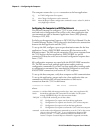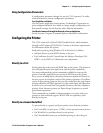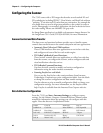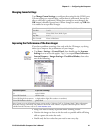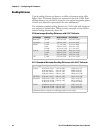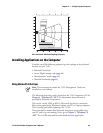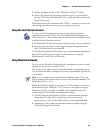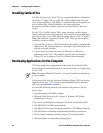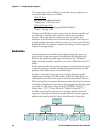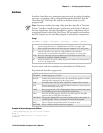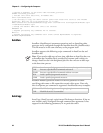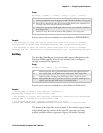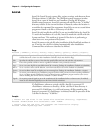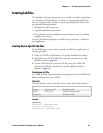
Chapter 3 — Configuring the Computer
46 751G Color Mobile Computer User’s Manual
Installing Cabinet Files
Cab files (short form of “cabinet” files) are compressed folders as defined by
Microsoft. A “cabinet” file is a single file, usually suffixed with .cab, that
stores compressed files in a file library. A compressed file can be spread over
several cabinet files. During installation, the setup application
decompresses the files stored in a cabinet and copies them to the user’s
system.
For the 751G, cab files register DLLs, create shortcuts, modify registry
entries, and run custom setup programs. Tap a cab file to extract that file or
place the cab file on one of the approved storage devices in the “\CabFiles”
folder, then perform a warm-boot on the 751G. There are two methods
available to extract a cab file:
• Tap a cab file to extract it. With this method, the cab file is automatically
deleted when the extraction process is successful, unless the cab file is set
with the read-only attribute.
• Use the AutoCab method to extract all files when a cold-boot is
performed on the 751G. This method is on the Intermec Developer
Library CD, see its Software Tools User’s Manual for information.
Developing Applications for the Computer
751Gs run applications programmed in Microsoft Visual Studios 2005.
Use this chapter to understand what you need to develop a new application
for the 751G.
Use Resource Kits from the Intermec Developer Library (IDL) to develop
applications for your 751G, which are downloadable from the Intermec
web site at www.intermec.com/idl.
You need the following hardware and software components to use the
resource kits:
• Pentium desktop, 400 MHz or higher
• Windows 2000 (Service Pack 2 or later) or Windows XP (Home,
Professional, or Server)
• For native and managed development, Microsoft Visual Studio 2005
• 128 MB RAM (196 MB recommended)
• 360 MB hard drive space minimum installation (720 MB for complete)
• CD-ROM drive compatible with multimedia desktop specification
• VGA or higher-resolution monitor (Super VGA recommended)
• Microsoft Mouse or compatible pointing device
Note: Microsoft eMbedded Visual C++ 4.0 may be used, but some features
are not available.



